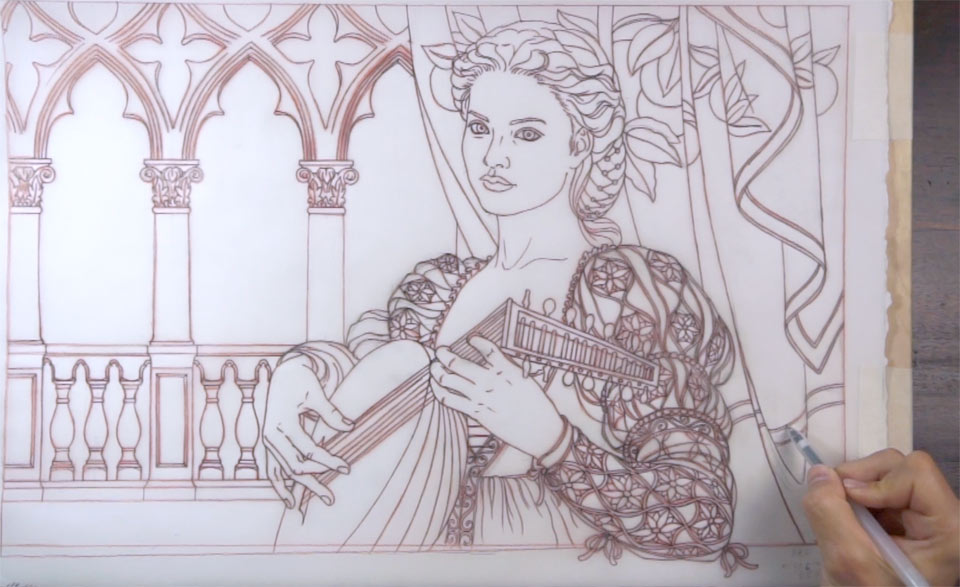A self-study, self-paced course where you can learn how to paint in watercolor by watching video lessons and doing assignments
$297 USD
ENROLL NOWA self-study, self-paced course where you can learn how to paint in watercolor by watching video lessons and doing assignments
$297 USD
ENROLL NOWOne-to-one, unlimited and custom-tailored to your skills and needs Personal Tutoring by the Watercolor Academy teachers
$997 USD
ENROLL NOWVideo lesson by Vladimir London
In this short but incredibly useful video lesson, you will discover the finest ways of transferring drawings onto watercolor paper.
Of course, the simplest way is to directly draw onto watercolor paper using a graphite pencil, especially when the design is very simple and you do not have to redraw it many times while looking for a better composition. This works well if do not use an eraser too much.

For example, I am currently making a quick sketch of an apple directly onto watercolor paper. This drawing will be used in one of the video lessons within the Watercolor Academy course.
If you have a more complicated design however, such as this organic pattern, you can draw it directly onto tracing paper. This type of paper is very suited to the use of graphite pencil, and is very resistant to harsh erasing, so you can redraw and correct the image as many times as you would like to. Because this pattern design is fully symmetrical, I can flip over the tracing paper with the finished drawing, placing it on top of the white watercolor paper.
Now that the graphite pencil marks are facing downward, I can repeat this drawing in pen, outlining every single line, in order to transfer this design onto white paper.
The tracing paper is fixed to the board at one side with masking tape, which makes it easy to lift it open, in order to check the quality of transferred lines. This makes it possible to produce a more complicated design without having to handle the watercolor paper too much. This also prevents me from touching the white surface with my hands, and there is no need to correct any drawing mistakes with an eraser, which can accidentally damage the watercolor paper surface. The masking tape keeps the paper in place, so that I do not have to realign it with the design every time I put it back.
Another way of working on the composition is to make a cartoon. 'Cartoon' is a word in fine art which means a full-scale preparatory drawing that will be later transferred onto the painting support, which in our case, is the watercolor paper. There are four steps in order to do this: first, make the cartoon drawing. Secondly, outline this drawing onto tracing paper. After this, the tracing paper must be turned over, with the drawing repeated again on its reverse side. Finally, the tracing paper must be placed on top of the clean watercolor sheet and the whole drawing will have to be outlined once again. This final step can be done in pen; this allows us to see clearly which lines are outlined and which lines are remaining. You can also flip over the tracing paper from time to time, to check if you have missed any lines. Because this composition is not symmetrical, and even has writing on it, the design of the tracing paper has to be reversed, otherwise you will get a mirror image on the watercolor paper.
So far in this lesson, I have only used a graphite pencil for drawing. But what if I was feeling even more creative and wanted to make a drawing in color?

In order to produce a drawing in color, I am using a red pencil to outline the composition on the other side of the tracing paper. Once this step is complete, I can place the tracing paper on the watercolor sheet with red pencil marks facing downward. Now, I will do the usual steps, fixing tracing paper to the board at one side with masking tape. I also remove the clean protective sheet placed between the watercolor and tracing papers, in order to prevent the red drawing from smudging.
With the tracing paper fixed in place, I can transfer every single line by repeating the drawing in black pen. Whilst doing this, I check how well this is working by flipping the tracing paper open every so often. I use a black pen to clearly see which lines are already red, and which lines are still remaining to be transferred.

When the drawing is finished, I can use the same red pencil that I used before in order to fix any lines if needed. If you have wondered why I prefer to make a drawing in red pencil, rather than graphite, this is because such a drawing will fuse into a colorful artwork and look a part of it. However, this is entirely optional – a graphite pencil will do the job just as well.
A self-study, self-paced course where you can learn how to paint in watercolor by watching video lessons and doing assignments
One-time payment - Lifetime membership
$297 USD
One-to-one, unlimited and custom-tailored to your skills and needs Personal Tutoring by the Watercolor Academy teachers
One-time payment - Lifetime membership
$997 USD